#fish essay
Explore tagged Tumblr posts
Text
What Is and Isn't a Fish: a List
A list of the animals I discussed in my fish essay, but for those who don't want to scroll through paragraphs of text to find out if an animal is or isn't a fish. Just CTRL+F your way through here!
I'll add onto here more animals whenever I get asked about them being fish. See my fish essay here!
Some notes before you proceed:
Yes, all tetrapods are fish! We are phylogenetically fish, as we are and our ancestors were lobe-finned fish! "Fish" in the phylogenetic sense is a paraphyletic group if you try to exclude tetrapods, so it is frankly impossible.
How come tetrapods aren't listed as fish then? Long answer, read my essay. Short answer, me and other fish accounts tend to operate on the morphological definition of fish, so does most of the world. Here I use the morphological definition of "fish".
Fish:
Jawless fish
Hagfish
Lamprey
Cartilaginous fish
Sharks
Dogfish
Whale shark
Chimaeras/Chimeras/Ghost sharks
Ratfish
Ray
Stingray
Skate
Ray-finned fish
Teleosts
Catfish
Eels
Moray eel
Seahorse
Sea dragon
Lobe-finned fish
Coelacanth
Lungfish
Not Fish:
Crustaceans
Krill
Shrimp
Crab
Crayfish/Crawfish/Crawdad
Lobster
Spiny lobster
Triops
Mantis shrimp
Barnacle
Isopod
Copepod
Shellfish
Mollusks/Molluscs
Gastropods
Sea snail
Sea slug
Snails and slugs in general
Sea angel
Sea hare
Sea bunny
Cephalopods
Octopus
Squid
Cuttlefish
Nautilus
Inkfish
Bivalves
Clam
Mussel
Scallop
Oyster
Chiton
Chelicerates
Horseshoe crab
Sea spider
Water mite
Diving bell spider
Cnidarians
Jellyfish/Sea jelly/Jelly
Coral
Sea anemone/Anemone
Siphonophores
Portugese man o' war
Echinoderms
Sea cucumber
Sea pig
Feather star
Sand dollar
Sea biscuit
Sea cookie
Brittle star/Serpent star
Sea urchin
Starfish/Sea star
Comb jelly
Lancelet
Tunicates
Sea squirt
Salp
Annelids
Bristle worm
Bobbit worm
Spoon worm
Giant tube worm
Bone-eating worm
Sea mouse/Sea mice
Feather duster worm
Christmas tree worm
Leech
Flatworm
Amphibians
Salamander
Amphiuma
Mudpuppy/Mud puppy
Waterdog
Olm
Axolotl
Siren
Frog
Toad
Tadpole
Caecilian
Reptiles
Sea snake
Water snake
Snakes in general
Sea krait
Turtle
Snapping turtle
Softshell turtle
Sea turtle
Terrapin
Marine iguana
Crocodilian
Crocodile
Alligator
Caiman
Gharial
Bird
Penguin
Seagull
Loon
Swan
Mammals
Whale
Orca
Baleen whale
Toothed whale
Dolphin
River dolphin
Porpoise
Narwhal
Beluga whale
Sperm whale
Pinniped
Seal
Sea lion
Leopard seal
Elephant seal
Walrus
Sirenian
Manatee
Sea cow
Dugong
Otter
Sea otter
Beaver
Hippo
Platypus
Muskrat
Water shrew
324 notes
·
View notes
Text
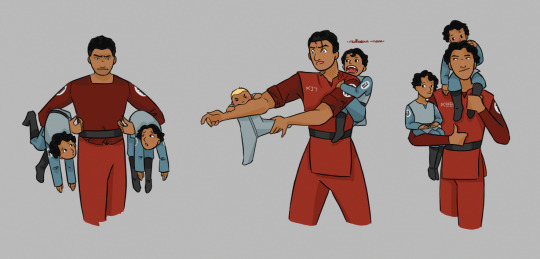
Cadets
(aka trash children, chaos children, and children who understand 98 is getting graded on this)
Inspired by @thefoundationproject! Closeups under the cut:
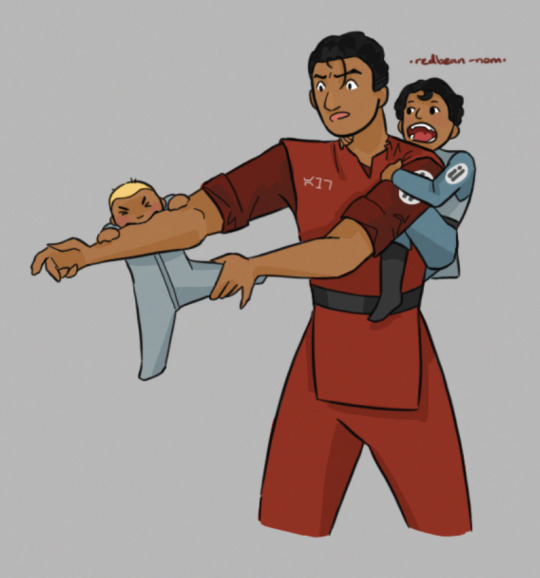
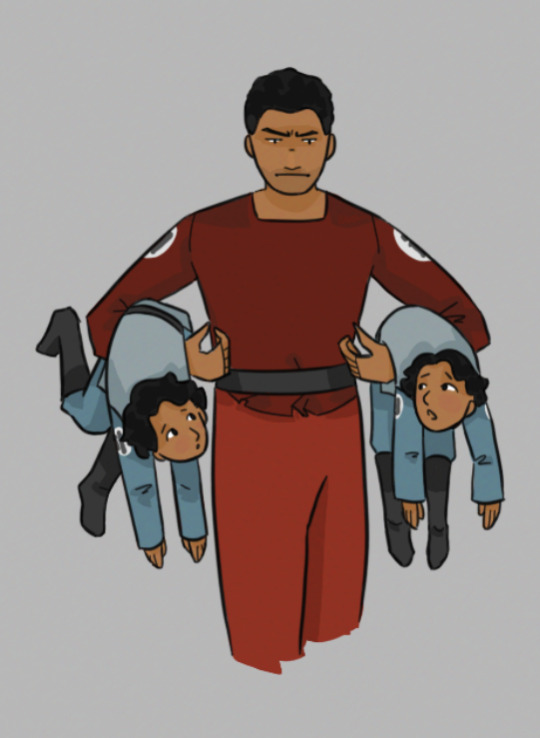

jesse got this pic from jangotat:
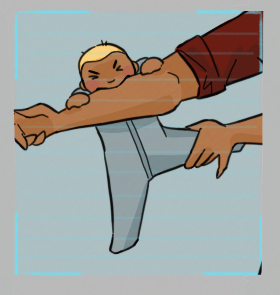
#star wars#tcw#soft wars#doodling in the soft wars sandbox#i think that'll be my tag for these things#alpha 6#commander fox#commander neyo#alpha 17#captain rex#commander wolffe#jangotat#commander doom#commander davijaan#(probably?)#shebse#edee#chekar#i may have messed up the ages oops#but hey we can pretend that the shebse found rex when he was a baby/toddler but he didn't officially join the squad until he was older!#hopefully i did 6's expression justice#against his better instincts he loves his trash children but he is also so so tired of fishing them out of the garbage#6 is grumpy as always; 98 is smug as always; and 17 is too busy getting bitten by a baby to have any other concerns at the moment#(he is about to have many more concerns)#wolffe climbed up 17s back to bite him while he was distracted with the tubie gnawing on his arm#specifically to bite 17s neck because he saw a video of an actual wolf taking down a space-deer and wanted to try it out#i just realized the alphas were still in training for most of the cadet-raising#poor 17 had to write strategy essays or whatever with four 10 yr olds competing to see who can provoke him the most#and a 6 yr old chomping on his ankles#not to mention 16 in the soft wars eu dealing with half of 44's squad on top of his own cadets and probably assorted shebse too
424 notes
·
View notes
Text
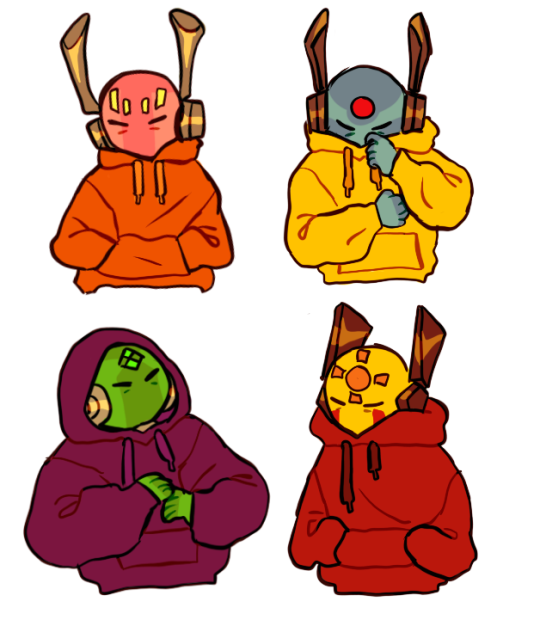
give them cozy hoodies NEOOWWWWW
#rain world#five pebbles#looks to the moon#no significant harassment#seven red suns#ILL WORK ON ESSAY NOW I SWEAR#art#fish makes art
1K notes
·
View notes
Text
I’m such a sucker for the ways that a medium shapes a piece of art, and I’ve especially always been a sucker for the way that applies to Minecraft roleplay, so watching Whitepine has been phenomenal
There are so many moments where a character will do something that isn’t easily portrayed in Minecraft (thinking at the moment of the sequence where Pyro is waking up), and so the camera will cut away and we’re left to infer what is happening based on previous actions and sound design. And it works stunningly! It fits right in with the rest of the cinematography, what with there being so many shots of stillness and silence.
(Not to be too silt verses brained in a mcyt post, but it brought to mind something that jon ware said once about moments of silence being just as important as moments of speech when it comes to voice acting. I thought the silences in Whitepine were so, so impactful)
And that stillness was all perfectly contrasted in the last minute or so when the camera shakes for the first time! We get a moving shot too, which really hadn’t happened if I remember correctly. God, the cinematography of this was simply beautiful, and I am incredibly excited for the rest of Whitepine.
282 notes
·
View notes
Text

Thinking about riptide 86 again. Shocker to absolutely no one
#I couldn’t write another 8 billion paragraph essay again that already exists on this account#so I took to shitty doodles instead#jrwi#just roll with it#jrwi fanart#just roll with it fanart#jrwi riptide#just roll with it riptide#albatrio#gillion tidestrider#jrwi chip#chip jrwi#chip james#jay ferin#jrwi fnc#jrwi fish and chips#honkceasar
258 notes
·
View notes
Text


(Second fish is called Formalo Ray, sorry for the awkward crop)
God damnit. God fucking. This is a metaphor for Teyvat and otherworldly knowledge/the abyss, isn't it? Innocence giving way to greed, which could be described as a form of ambition, and wording that may imply the world will be consumed by it.
With an additional link between the colour gold and innocence, which is interesting considering that's associated with Celestia- and potentially Aether and Lumine as well.
#genshin#genshin lore#looks at venti's stripper-i mean archon outfit being very golden too; maybe we should fuck with that in corrupted!venti art#this fucking game man. you idly click through fish descriptions for 5 seconds and find another essay on the apocalypse
114 notes
·
View notes
Text
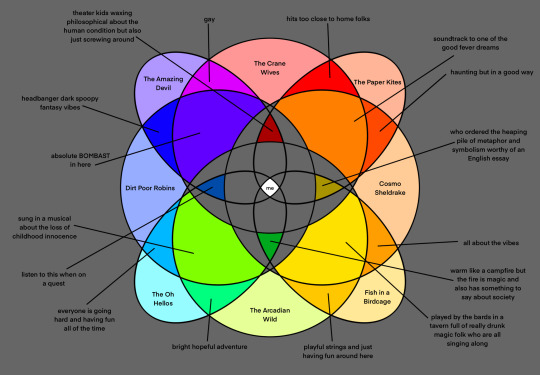
I was compelled last night and I’m quite honestly scared of whatever 11:59 PM me intended for those middle sections. At least I still know my colors when sleep deprived, and I’m sure someone else on here can fill the blank spots out better than I can on a full eight hours of shut-eye.
#oh god on high what do i tag this with#the crane wives#the paper kites#cosmo sheldrake#fish in a birdcage#the arcadian wild#the oh hellos#dirt poor robins#the amazing devil#venn diagram#me running my mouth#im pretty sure you could put all the text boxes in this file in a jar shake it to hell and back and pour it over the diagram#and itd still make some degree of sense#says a lot about my music taste eh mates?#anyone who sees this and relates to any degree please o please say so#i have essays worth of analysis i can spit out about most of these musicians#not on command though i need to get kinda existential first#theres three paragraphs about the eurus ep hanging out in my drafts and i think my motivation for that is somewhere behind the couch#with the spiders and my childhood nail clippings
128 notes
·
View notes
Text
~ 𝙸 𝚜𝚙𝚢 𝚠𝚒𝚝𝚑 𝚖𝚢 𝚕𝚒𝚝𝚝𝚕𝚎 𝚎𝚢𝚎… ~
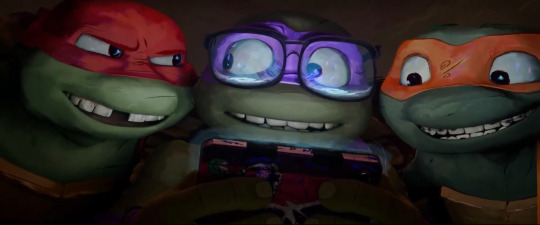



❤️👻💜👻🧡👻❤️👻💜👻🧡
·̩̩̥͙**•̩̩͙✩•̩̩͙*˚𝚃𝙸𝙲����𝙻𝙴𝚃𝙾𝙱𝙴𝚁 𝙳𝙰𝚈 𝟷𝟹: 𝙲𝙰𝚁 𝚁𝙸𝙳𝙴˚*•✩•̩̩͙**·̩̩̥͙
𝙶𝚎𝚗𝚛𝚎: 𝙵𝚕𝚞𝚏𝚏
𝚆𝚘𝚛𝚍𝚜: 𝟷,𝟾𝟺𝟻
𝙻𝚎𝚎: 𝚁𝚊𝚙𝚑 🐢❤️
𝙻𝚎𝚛’𝚜: 𝙳𝚘𝚗𝚗𝚒𝚎 🐢💜 𝚊𝚗𝚍 𝙼𝚒𝚔𝚎𝚢 🐢🧡
𝚂𝚞𝚖𝚖𝚊𝚛𝚢: 𝚁𝚊𝚙𝚑, 𝙳𝚘𝚗𝚗𝚒𝚎 𝚊𝚗𝚍 𝙼𝚒𝚔𝚎𝚢 𝚊𝚛𝚎 𝚘𝚞𝚝 𝚘𝚗 𝚊 𝚌𝚊𝚛 𝚛𝚒𝚍𝚎 𝚠𝚒𝚝𝚑 𝚝𝚑𝚎𝚒𝚛 𝙳𝚊𝚍 𝚠𝚑𝚒𝚕𝚎 𝙻𝚎𝚘 𝚒𝚜 𝚜𝚝𝚞𝚍𝚢𝚒𝚗𝚐 𝚠𝚒𝚝𝚑 𝙰𝚙𝚛𝚒𝚕 𝚋𝚊𝚌𝚔 𝚊𝚝 𝚑𝚎𝚛 𝚊𝚙𝚊𝚛𝚝𝚖𝚎𝚗𝚝…𝙸 𝚠𝚘𝚗𝚍𝚎𝚛 𝚠𝚑𝚊𝚝 𝚌𝚘𝚞𝚕𝚍 𝚑𝚊𝚙𝚙𝚎𝚗 𝚒𝚗 𝚝𝚑𝚊𝚝 𝚊𝚖𝚘𝚞𝚗𝚝 𝚘𝚏 𝚝𝚒𝚖𝚎…
(𝙰/𝙽: 𝙱𝚞𝚝 𝚖𝚘𝚜𝚝 𝚒𝚖𝚙𝚘𝚛𝚝𝚊𝚗𝚝𝚕𝚢: 𝙳𝚘𝚗’𝚝 𝚋𝚎 𝚝𝚑𝚊𝚝 𝚐𝚞𝚢! 𝚃*𝚌𝚎𝚜𝚝 𝚊𝚗𝚍 𝙺𝚒𝚗𝚔/𝙽𝚂𝙵𝚆 𝚋𝚕𝚘𝚐𝚜 𝙳𝙽𝙸!!!)
𝚆𝚊𝚛𝚗𝚒𝚗𝚐𝚜: 𝙲𝚞𝚜𝚜𝚒𝚗𝚐, 𝚝𝚒𝚌𝚔𝚕𝚒𝚗𝚐, 𝚊 𝚖𝚒𝚗𝚘𝚛 𝚖𝚎𝚗𝚝𝚒𝚘𝚗 𝚘𝚏 𝚜𝚕𝚒𝚐𝚑𝚝 𝚘𝚟𝚎𝚛𝚜𝚝𝚒𝚖𝚞𝚕𝚊𝚝𝚒𝚘𝚗 𝚊𝚗𝚍 𝚜𝚘𝚖𝚎 𝚓𝚘𝚔𝚎𝚜 𝚊𝚋𝚘𝚞𝚝 𝚍𝚛𝚞𝚐𝚜 👁️👄👁️…
**•̩̩͙✩•̩̩͙*˚𝚂𝚕𝚘𝚠𝚕𝚢 𝚋𝚞𝚝 𝚜𝚞𝚛𝚎𝚕𝚢 𝚙𝚘𝚜𝚝𝚒𝚗𝚐 𝚝𝚑𝚎𝚜𝚎 𝚖𝚍𝚗𝚍𝚑𝚜𝚓𝚓𝚜˚*•̩̩͙✩•̩̩͙*˚*·̩̩̥͙



“Are we there yet?” Mikey whined loudly.
“Uh…no?” His immediate older brother said, sighing impatiently.
“…Are we there yet now?” Mikey whined louder.
“No, Mike.” Donnie huffed through his palm as he rested his cheek on his hand, effortlessly playing his Nintendo Switch as he started to drown out his younger brother’s consistent complaining and restlessness.
Which…you would think he got used to by now.
The orange cladded turtle let out a short grunt loudly and dramatically, dragging his hands down his face, “Are we there yet now—?”
“Mikey, I swear to God if you ask that question one more damn time I will not hesitate to open the car door and throw you into ongoing traffic.” Raph growled lowly at the youngest.
“Boys…be nice to each other, please…” Splinter exclaimed from the front seat as he drove.
“But Dad! Mikey’s being annoying!” The tallest turtle moaned and groaned as he sunk in the middle seat.
“When is he not?” Donatello mumbled under his breath.
“Boys…” The rat said warningly.
“…Sorry, Dad…” The teenager’s grumbled collectively as they glared at one another.
The rodent father sighed, plugging his phone into the car unit as he stopped on a red light. “…Why don’t we listen to some Podcasts on the radio?” He offered, trying to find something that his boys would enjoy that didn’t involve ripping each of their tails off.
“Yohou listen to podcasts?” The purple banded teenager exclaimed curiously as he took off his headphones.
“Of course!” Splinter announced proudly, “I’ve been listening to this one that Spy-itify recommended me…it’s really good and well thought out!”
“It’s…It’s…'Spotify', Dad…” The hazelnut eyed teen corrected.
“That’s what I said; 'Spy-itify'.” The father said simply, causing Raph to facepalm and stuff his face right back into his phone.
“What’s the podcast about?” Michelangelo asked as he leaned his head on the closed window as Splinter started to drive again once more.
“It’s about this man talking about nature…it’s extremely interesting; I think you three will enjoy it.” The charcoal eyed rat explained.
“Huh…sounds cool enough.” Donnie snickered, “What’s the guy’s name? Like, the one who mainly talks in the podcast and stuff.”
“Zach Green.” The rat said.
“He sounds like a drug dealer…” Raphael mumbled under his breath, earning some small snickers from his younger brother’s as their Dad started to play the podcast in the vehicle.
A guy, most likely 'Zach Green', started singing as there was a ukulele playing in the background…
…And he sang…
…And sang…
…And. SANG.
And the three teenager’s wouldn’t have minded if the dude sounded…y'know, good!
But he didn’t sound good.
At all.
“Grass is green~! The green is the grass~! The grass is the green and the green itself is greeeen~!” The speaker’s sung as the three teenagers collectively sighed as the Podcast continued to play amongst them.
“…How about we play 'I spy' instead of listening to Shaggy get high?” Mikey suggested as his Dad hummed along to the tune…
Poor soul probably knew this song from heart…
“Anything but this.” Donnie agreed.
“Best idea I’ve heard all day.” The second oldest murmured, crossing his arms as he looked at the youngest expectantly, “Well? You gonna say 'I spy' or what?”
“Let a guy think for a moment!” Mikey shrieked, “Okay, okay, okay…I spy with my little eye—”
“—More like pink eye.” The turtle with glasses giggled under his breath, trying to cover it as a cough as he saw his younger brother side-eyeing him. “Y'know, Dee…we could really go.” The orange banded teenager glared.
“Bet. Catch me outside. 3:30 on the dot.” The purple cladded mutant threatened.
“Bet.” The youngest repeated.
Donatello raised an unamused brow, “I already said 'bet' you phrase snatcher!”
“You don’t own the word 'bet', you four-eyed freak!”
“God— 'BET' YOURSELVES!” Raphael snapped, taking a deep breath as he pinched the bridge of his snout, “I swear to literally anything and everything holy I am completely envying the fact that Leo doesn’t have to suffer in this freaking hell-hole with me.”
The second oldest leaned forward and tapped his Dad’s shoulder, “Speaking of which…how come Leo got to study with April while I—”
“We.” Donnie corrected swiftly.
“—I had to stay with these two excuses for mutants, Dad?” Raphael continued, frowning deeper as his Dad became unresponsive and became completely entranced by the radio, “Dad? Dad? Dad? Daddy? Father? Dad— aaaaand you have your 'I’m locked in to this music' face…gotchu...” The tallest turtle huffed as he sat back down in the middle seat.
“As I was saying before I was rudely interrupted.” The youngest huffed, “I spy something…grey/gray.”
“Grey/Gray? Grey/Gray as in ashy? Ashy as in you?” Donnie smirked, his smirk turning to a smug grin as the orange banded teen glared back at him with a mix of disdain and pure disgust.
“Donnie, I swear—”
“Is it the car seat?” Raph muttered, dying in complete humiliation about the fact that this was his onlysource of entertainment.
Michelangelo shook his head, crossing his arms as he leaned back on the seat, “Nope. Try again.”
“Is it…Dad’s fur?” The turtle with glasses guessed.
“Nooooooope!” The smallest mutant dragged out, sticking his tongue out at the second youngest causing Raph to just sigh, slumping in the chair further.
This car ride was going to be his 13 Reasons Why…
“Okay…seriously, though. Raph-Taff, what’s up?” Mikey asked carefully, looking over his older brother’s stiff and utterly overall unhappy demeanor.
The second oldest just grunted, glancing away and his frown drooping as he locked eyes with his immediate younger brother, “You can tell us anything.” Donnie assured.
“Well…not everything. Almost everything. Semi-everything.” The genius clarified, “Buuuut you get the point…”
“No, no Ihi really really dohon’t...” The red banded teen grimaced.
“What Egghead Humpty Dumpty is trying to say is that you can tell us what’s bothering you. You haven’t been your usual…let’s just say 'Sarcastic Sappy Self'.” The hazel eyed teen confirmed, biting back a chuckle as he saw his purple themed brother gasp in offense.
“I just needa get out of here…” Raphael emphasized, rubbing his temples like he’s seen centuries worth of knowledge, “School was rough. School is annoying. Kids are annoying. Y'all are annoying— no offense.”
“None taken.” The two youngest said in sync.
“And I just need to distress…” Said the older turtle, going on his phone only to be met with a completely pitch black screen, “And my phone is dead. Yip dee doo da fuckin' day…” He cursed.
Mikey rubbed his chin in thought, leaning on the inside door hand rest, “I have an idea for that, actually. Just trust me.”
“'I have an idea' and 'just trust me'…two words I never want to hear come out of your mouth ever again.” Donatello insisted almost immediatelty.
“Shut up.” The smallest mutant exclaimed to his immediate older brother, inhaling and exhaling loudly before continuing, “Okay…so I spy with my little eye—“
“Seriously?” The elder mutant deadpanned.
“Trust me, I said!!!” The younger shouted once more to try and get his point across, “I spy something…black.”
“…Black?” The second youngest asked, tilting his head.
“Black.” Mikey confirmed.
“Ohooo…black.” Donatello snapped his fingers, nodding as he relaxed in his seat.
“Black!” Michelangelo beamed as Raphael looked around in confusion, wondering if his younger brother’s were going to elaborate on this whole 'black' nonsense or if they were just going to communicate via gibberish.
The red banded teen scratched his head in confusion, “…What is happening…?”
The youngest gave his red cladded older brother a knowing look, causing the red cladded mutant in question to just simply sigh longly, “Right riiiight…trust. I got it…”
“Uhhh…” Raphael hummed, looking around the car for something…well, black; as his little brother’s so veeeeery clearly stated.
The chocolate eyed teen raised an uncertain eye ridge, pointing at his own black sweatshirt that he was wearing.
The purple and orange duo nodded, “See? Black!” Donnie grinned, poking his older brother’s sides and causing his older brother in question to shriek loudly and try to cover his middles, wiggling his way over more to Michelangelo.
Whiiiiiich…was a first.
“Yeah! Black!” The smallest mutant smirked cheeringly, prodding the other side of the black sweatshirt wearing boy, “You got it?”
“Ihihi gohohot ihihat I-Ihi gahat ihat!!” Raph said immiediatley, kicking his legs on the car floor as he pushed on the other two’s shoulder’s. “Ehhhhh…I don’t think you do…” The young genius teased lightly.
“Dohon’t a-act smahart with me yohou l-lihittle shIHIT NO!! Mihikey nonononohoh!” He said as he saw Mikey wiggling his fingers near his neck, causing him to try and hide his face in Donnie’s shoulder, swatting the youngest away.
“D'aww~! Hey, big bro! Need a hug~?” The scientist said innocently, wrapping the taller in a hug as the shortest of the three skittered and scratched the red banded mutant’s shell lightly; almost barelytouching it.
The red banded mutant in question wheezed loudly, banging his fists on the car seat whilst his legs stomped up and down, “Wohohoah! Mr. Deflating Balloon Man— yohou okay?” Mikey teased, making sure to trace the patterns on his elder brother’s shell in a very veeeery mean manner.
“Are you boys alright back there?” Splinter asked, getting out of his trance as the podcast soon and finally ended.
“We’re fine!” Donnie beamed, wiggling his fingers into the crooks of the chocolate eyed teen’s neck right beside him, “Right, Raph?”
Raph squealed loudly with laughter, not answering.
Well…not answering in word form, perhaps.
The Father rolled his eyes fondly at his son's, looking away from the rearview mirror and focusing back on the road.
“See!? He agrees.” The youngest beamed, “We’re perfectly fine and dandy, Dadio.”
“'Fine and dandy?'” Donnie repeated in amusement, causing the orange banded teen to almost laugh as loudly as Raph currently was.
Key word: Almost.
“Fine and dandy.” Michelangelo confirmed, kneading his hot-headed brother’s hips and sides as the taller leaped like a drunk frog, “STAHAHOP!! HIC LEHEHET HIC HIC GOHOHOH!!!”
“People are gonna think we’re beating you up or something by the way you’re squirming, bud.” The purple banded turtle joked, letting go of the taller teenager as the smaller teenager spidered his fingers all over his tummy.
“MIHIHIHIKEY!!!” The older wailed, pushing the other’s hands away as they slowly but surely stopped.
The two youngest’s giggled, fist bumping each other for successfully turning Raph’s frown upside down.
Splinter drove into the O’Neil’s driveway as Leo walked out of the front door to the apartment, waving his goodbyes to April as he got into the car.
The eldest sat in the front seat, buckling up as their Dad drove to their home.
The blue banded teenager let out a small snort, looking towards the back to see his immediate younger brother’s face the exact same shade as his own bandana, “Jeeheez..whahat dihid I miss?”
“I daha— hic don’t wanna tahalk ahabohout it…” Raph grumbled, his beet red blush deepening on his face as Donnie and Mikey snickered slightly, giving each other one last fist bump of victory.
·̩̩̥͙**•̩̩͙✩•̩̩͙*˚𝙵𝙸𝙽˚*•̩̩͙✩•̩̩͙*˚*·̩̩̥͙
(𝙿.𝚂.: 𝙸𝚏 𝚢𝚘𝚞 𝚎𝚗𝚓𝚘𝚢𝚎𝚍 𝚝𝚑𝚒𝚜 𝚏𝚒𝚌, 𝚙𝚕𝚎𝚊𝚜𝚎 𝚛𝚎𝚋𝚕𝚘𝚐!!!)
#Mutant Mayhem tickle#Mutant Mayhem tickle fic#Mutant Mayhem tickle fanfiction#Lee!Raph#Ler!Mikey#Ler!Donnie#TAG TEEAAAAM BACK AGAIN 😙✨‼️#I love writing for Mutant Mayhem if you couldn’t tell#Speaking of…I need to finish TOTTMNT 🫥…#I got to the episode where Raph was fighting those sea fish thingies and I just got bored LMFAOOO#The movie is way better than the series I’m gonna give it a buck#AND THERE WAS NO THEME SONG⁉️⁉️⁉️#WHERE ARE MY HERO’S IN A HALF SHELL 😭😭😭#But I feel like Raph gets overstimulated PRETTY quickly#Especially when it comes to enclosed spaces…so my boy was somewhat overstimulated in this one but dw his bro’s helped him out :3#AND I NEED MORE REP OF THE YOUNGEST SIBLINGS#WE BICKER 24/7#Grass is green you guys ☝🏾🙂↕️#Grinding on homework and tests and essays#I refuse to have a grade lower than 80…that’s the goal 🤞🏾🤞🏾#ADHD is a biiiitchhhhhhh I can’t focus for shit 😪#BUT ONE MORE WEEK AND THEN ITS THANKSGIVING BREAK OH ORAISE THE LORD#😎CUZ🥳IIIIIII🙂↕️AAAAAMMMMM😩FREEEEEEE🥸#Whoever gets that refrence ilysm ^
38 notes
·
View notes
Text

some kyle + colton doodles <3 happy belated birthday kyle !!
#indycar#kyle kirkwood#colton herta#indycar fanart#my art#some doodles bc im slammed with homework rn#i'll start working on the next tarot card after i finish writing an essay due tomorrow#someone get kyle a women want me fish fear me hat RIGHT NOW#i fear i had to draw them bc a) kyles bday and b) if i didn't i would go insane
41 notes
·
View notes
Text

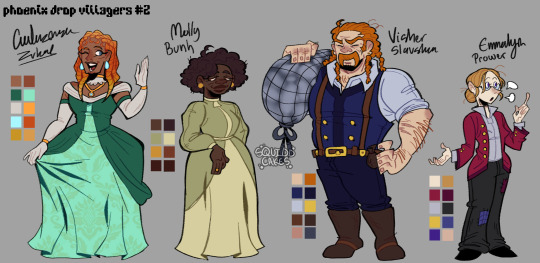
Ladies and gentlemen (and, creatures), I have finished my second PD villagers line-up! My favorites to do were Molly and Emmalyn they're just <3 (I also re-did my first line-up with some minor changes since my art skills have improved since).
#also I fucking love how I did Cadenza but if I talk abt her its gonna be a whole ass 30 pg essay so that's for another post#also we need to recognize visher more yall are missing out on the fishing dilf#I like to think him and dale have a rivalry or smthn#mcd#minecraft diaries#aphmau#aphblr#mcd emmalyn#mcd molly#mcd cadenza#cadenza zvahl#mcd visher#art#character design#fan art
646 notes
·
View notes
Text
Strap in boys, famous tumblr user Tigers1o1, aka The FNC Guy, is going to begin relistening to JRWI Riptide soon in order to do an arc by arc micro analysis of Chip’s character, development and relationships to others throughout the campaign
#tigers rambles aimlessly#I’m fucking jnsane for this but I’m basically going to relisten eith the express intent of paying attention to every time#bizly opens his mouth#I’m going to do an jntense rhetoric analysis of this fucker#no one is going to know his as well as i#and maybe at the end ill compile everything and make a script for a youtube video essay#cause I’m a psychopath#jrwi#just roll with it#jrwi show#chip jrwi#gillion tidestrider#i’m that fnc guy#jrwi fish and chips#chip kisser#jrwi fnc#jrwi chip#fish n chips#fish and chips#chip bastard#chip lastname#chip james#analyzing the blorbo 🌊#jay ferin#jrwi ollie#old man earl#amanda rinn#polypirates#mockingjay
76 notes
·
View notes
Text
What Is and Isn't a Fish: an Essay and Guide by Fishyfishyfishtimes
A simplified list of the animals I discuss can be found here!
Hello folks! I created this post to have a kind of definitive essay/explanation of what is and isn't a "fish", starting with defining the term and going over animals that fit and don't fit the bill. As other fishblr artists, writers and educators must know too well, some people are confused about where this term begins and ends, mistaking other aquatic animals for fish. I have my fair share of arthropods and cnidarians as fish fact requests in my own askbox, heck, some years back a friend of mine asked me if clams were fish. The event that finally made me decide to write this was someone requesting that a fish-only account draw a crustacean, pondering to themselves if they count as fish.
I don't want to hold it against these people. It's impossible to know something when you've never been taught! So that's what I'm here to do, hopefully achieving a pretty correct and universal view ^^' If I make any mistakes please correct me. I'm learning all the same as everyone else is.
Definition of fish
Immediately, we run into a bit of a problem with the definition of fish. See, what the term "fish" means has fluctuated for centuries! For a long time, pretty much any animal that lived in water was a "fish" — I say "pretty much any" instead of "every" animal because for a long time sessile animals like sponges or corals were thought to be plants. This is why we have such remnants in our language like shellFISH, starFISH and jellyFISH, they lived in water so they were called such!
Occasionally these definitions would be changed for cultural convenience too. Many Christian churches take part in Lent, and in the Catholic church red and white meat is forbidden on Fridays and Ash Wednesday. In the Middle Ages, in my own country, Finland, this abstinence of red and white meat could last up to 140 days! To make fasting easier, many animals were labelled fish for convenience so they could be eaten as well. These newfound "fish" included seals, beavers and swans, pretty much just anything that was aquatic or semiaquatic in nature.
Nowadays just going off of looks or behaviour won't do, though. There has been much more of an effort to define fishes coherently based on their anatomy and phylogeny, which is great! Problem is, that's easier said than done: fishes are an extremely diverse group, and uh.. not really a single group, either. I'll show you:
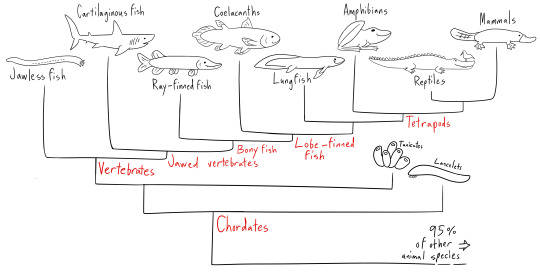
As you can see from this heavily simplified phylogenic tree, fishes are not a singular group like, say, mammals are! The animals that we group under "fish" are actually a part of several distinct lineages of animals, some more closely related to us than each other. Heck, tetrapods, which include amphibians, reptiles*, and mammals, are fish themselves! Phylogenetically speaking. Our ancestors were lobe-finned fish, and, well, you never stop being the previous taxon even when you evolve into something else. If you try to exclude tetrapods, no such unified group as "fish" exists. Still, when discussing fish, we tend to want to avoid talking about every vertebrate ever and instead focus on the very specific aquatic ones we mean when we say "fish". This is why many definitions of the term "fish" still exclude tetrapods, even if we share a common fishy ancestor. "Fish" describes more of a lifeform than it does a clade, much like the term "worm"!
(*birds are reptiles! This could be a whole post in and of itself, but I'm not here to write about that. Someone else has most likely taken up the task!)
Hooray, it's definition time! As stated previously, fishes are an extremely diverse group of thousands of species, and what terms might apply to the Atlantic cod may not apply to the yellowfin tuna or giant mudskipper, let alone a Pacific lamprey! Encyclopedia.com defines a fish as "an ectothermic chordate that lives primarily in water and possesses a cranium*, gills that are useful virtually throughout life, and appendages (if present) in the form of fins". Encyclopedia Britannica notes that "the term fish is applied to a variety of vertebrates of several evolutionary lines", instead highlighting five classes. These five classes are left partly unspecified, but ones that are mentioned are jawless fish, cartilaginous fish and bony fish (which still includes tetrapods, however), and the two classes left can be assumed to be two classes of extinct fish. Wikipedia defines a fish as "an aquatic, craniate**, gill-bearing animal that lacks limbs with digits". Tim M. Berra, an academy professor and ichtyologist, defines fish as "poikilothermic***, aquatic chordate with appendages (when present) developed as fins, whose chief respiratory organs are gills and whose body is usually covered with scales".
(*cranium=upper part of the skull **craniate=an animal with a skull ***poikilothermic=an animal whose internal temperature varies considerably)
From these more or less detailed definitions we can gather many defining features for fish: a cranium-having chordate, primarily aquatic, gill-bearing and uses gills as their main respiratory organ, lacking any limbs with digits, instead having their limbs be in paired and unpaired fins when present. Most fish are also ectothermic, meaning their body temperature is determined by their environment, but some can heat up parts of their body or their entire body in the case of the opah. Most fish also have scales, but not all, just like how most fish are fully aquatic, but some like lungfish or mudskippers can spend considerable time out of the water. Such is the way of these magnificent and diverse animals!
Finally, with all this out of the way, we can get into...
What is a fish!
Here, I will be detailing animals that are fish! Well, at least the broadest strokes; there are more than 30 000 fish species and if I listed them all we'd be here all life. I shall instead go over the major classes and list, in short, some groups that belong in them.
Jawless fish (Superclass Cyclostomi)
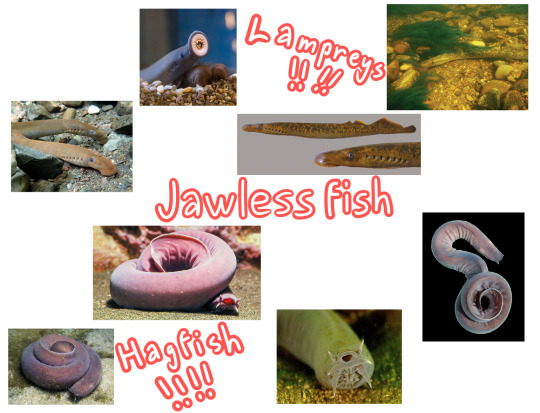
Jawless fish are often a topic of debate, especially in matters of their relation to each other and to jawed vertebrates. Evidence seems to point to hagfish and lampreys being closest related to one another and to lampreys being more closely related to jawed vertebrates than to hagfish (which would make hagfish craniates but not vertebrates). In the phylogeny tree above I decided to portray hagfish and lampreys as a monophyletic group, as molecular studies and microRNA analysis seems to point to a monophylegic superclass. Please note that this could go either way, though.
Jawless fish is a group containing two extant fishes, hagfish (class Myxini) and lampreys (order Petromyzontiformes)! Jawless fish are more "primitive" than other groups, for example both lack true vertebrae and scales. Still, they both have craniums and gills and they are aquatic, and so they have earned their place among fish!
Cartilaginous fish (class Chondrichthyes)
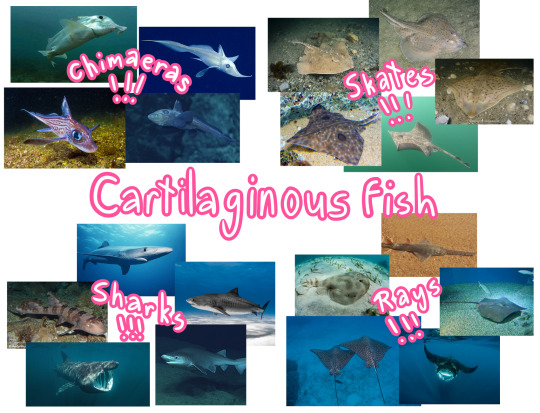
Surprisingly, I've found that this group has a lot of confusion surrounding it. I have received many a request confirming if sharks are fish, or asking if I'd cover a shark "even if it's not a fish". So I'll say it now: good news, sharks are indeed fish! So are their cousins, rays, skates and chimaeras, also known as ghost sharks! All of these fish have a primarily cartilaginous skeleton, tooth-like dermal denticles and lack gill covers and a swim bladder. Out of all the sharks, I also want to highlight that the whale shark, despite its confusing name, is a shark and not a whale. So, it is a fish!
Ray-finned fish (class Actinopterygii)
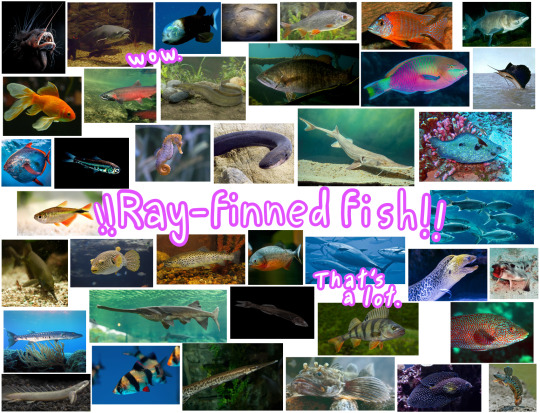
Name any fish, and there's a 96% chance the species name you said belongs to a ray-finned fish. Unless, like, you really like sharks. But this isn't about them.
Ray-finned fish are the biggest group of fish and incredibly diverse! It has your seahorse, your pufferfish, your bass, your tuna, your anglerfish, your clownfish, your salmon, your sturgeon, your lanternfish, your perch, your oarfish, your gar, your sardine, your moray eel... and this is only a tiny, tiny fraction of the groups that belong to this class! Defining features of ray-finned fish are that they tend to have a swim bladder and a bony skeleton (some exceptions though. Sturgeons, for one, have evolved a cartilaginous skeleton but they're still ray-finned fish). The largest group of ray-fins, the teleosts, also have leptoid scales, which are thinner and more flexible and grow with growth rings.
I want to bring special attention to some members of the ray-finned fish which tend to have a lot of confusion surrounding them and their heritage: eels and seahorses. Many people think these two are not fish due to their strange anatomy, like lack of scales or (many) fins and their elongated bodies, and I wouldn't blame them! Seahorses belong to family Syngnathidae, which also includes seadragons and pipefish. Eels, meanwhile, make up the order Anguilliformes. All of these long friends of ours are fish!
Lobe-finned fish (clade Sarcopterygii)

I shall merely focus on the fishy fishy fish individuals of this class, which excludes tetrapods. Lobe-finned fish house the two extant species of coelacanths, and six extant species of lungfish! These fish are bony and their fins are placed at the tips of fleshy, lobelike stalks, resembling the limbs of tetrapods. It is thought that the common ancestor of coelacanths and lungfish and tetrapods had similar structures that then became the four limbs the members of our clade typically have. Coelacanths and lungfish are wonderful fishes and deserve a lot of love and respect, not only because they're our closest cousins but because they're unique and we have so much to learn about them!
So, these are the fishes! There are also extinct groups of fish, namely class Placodermi (armoured fish) and class Acanthodii (spiny "sharks"). I'm moreso an extant fish account however, and so I shall move onto...
What isn't a fish?
Now we get into the real meat of this post. Without further ado, here are some aquatic friends of ours that can be mixed up with fish very often!
Crustaceans (subphylum Crustacea)
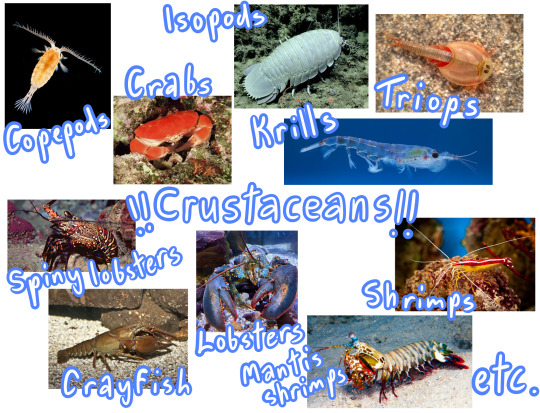
Many of our hard-shelled many-legged friends belong here! Crabs, lobsters, crayfish, shrimp, krill, isopods, triops, barnacles, copepods, you name it! Even though many crustaceans are aquatic or semiaquatic and have gills, you'll find that they're invertebrates that lack an internal skeleton (so no cranium, not even vertebrae)! We still love them though!
Mollusks (phylum Mollusca)
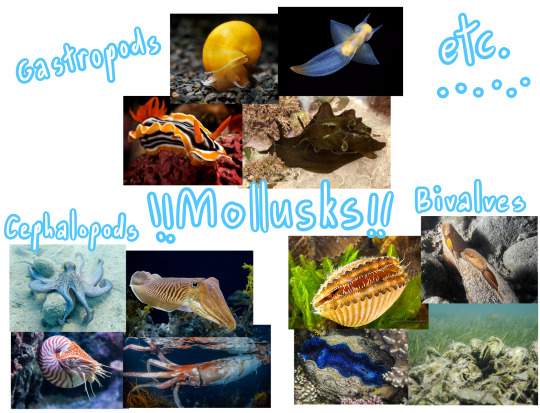
Creatures both soft and hard-shelled! Cephalopods like octopuses, squid, nautilus and cuttlefish, bivalves like clams, mussels, oysters or scallops, gastropods like sea slugs and snails and chitons go here! These friends of ours are also aquatic and have gills, some even have the suffix -fish (cephalopods used to be called inkfish, even!), but their lack of an endoskeleton is even more obvious than the crustaceans'. They're invertebrates, and therefore not fish!
Chelicerates (subphylum Chelicerata)
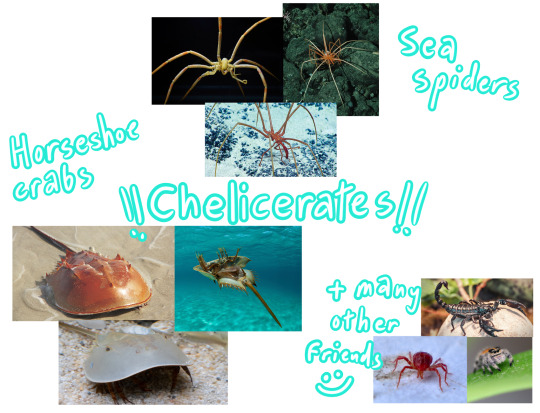
This group has many animals that are very hard to mistake for fish, namely spiders and scorpions, but horseshoe crabs and sea spiders are two groups of extant marine chelicerates! Both groups are aquatic, and horseshoe crabs have gills. However, they're both invertebrates, lacking a cranium or vertebrae. Other aquatic chelicerates exist, but they're usually very small, like water mites.
Cnidarians (phylum Cnidaria)

This phylum has the sessile corals and sea anemones and the usually more mobile jellyfish and siphonophores (includes the infamous Portugese man o' war!). I imagine corals and sea anemones are mistaken for fish less due to their sessile nature, but they're good to bring up nevertheless. None of these animals have a backbone, or, any bones really. They lack gills, they lack fins, they even lack the bilateral shape of fish. Jellyfish, despite the name, are indeed not fish! Some people suggest the name sea jellies be used for them instead, and I think it's much cuter.
Echinoderms (phylum Echinodermata)

Animals like starfish, sea urchins, brittle stars, sand dollars, sea cucumbers and feather stars go here. It seems that this pesky "-fish" -suffix is hard to shake off, as now we have the starfish. Once again, all of these slow-moving bottom-dwelling friends of ours are invertebrates, as they lack vertebrae or a cranium. Interestingly though, they are among our closest invertebrate relatives! So we ought to give them some props for that. I also want to mention that starfish can also be called sea stars, which ought to lessen confusion about their being too.
Comb jellies (phylum Ctenophora)
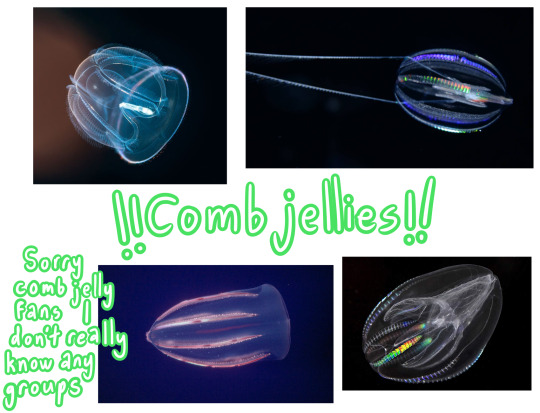
Comb jellies look a lot like jellyfish, but they belong in their own unique phylum! They have the same deal going on; they are invertebrates, they lack gills, they lack a cranium, they are simply aquatic.
Lancelets (subphylum Cephalocordata) and tunicates (subphylum Tunicata)
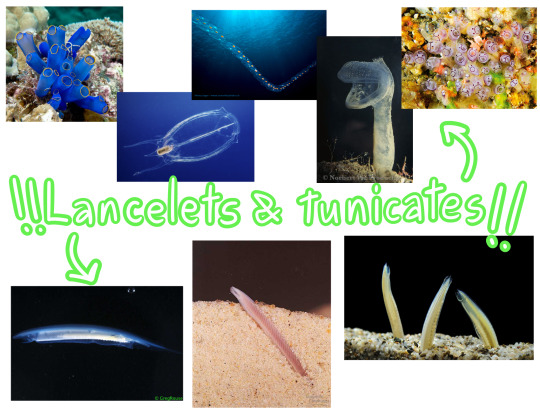
A double feature, because I wanted to save space didn't want these guys to be all alone! Lancelets and Tunicates, like sea squirts and salps, are chordates, which you can find in the phylogenic tree I drew all the way in the definitions section. They share many a feature with vertebrates, like a bilateral bodyplan, a notochord at some stage of life and a post-anal tail, but I'm afraid they're still not fish. They lack a cranium and their notochord does not develop into a vertebral column! Sorry friends, you tried. We can still hang out at the chordate convention.
Annelids (phylum Annelida)
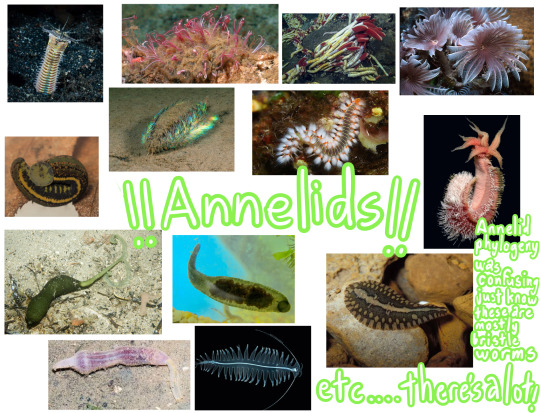
The infamous bobbit worm, bone-eating worms, sea mice, giant tube worms, feather duster worms, spoon worms, bristleworms in general, leeches... many, many worms go here! Pretty self-explanatory: they are invertebrates, even when they live in water. They're extremely cool invertebrates too! I suggest taking a look at some of them, there's many interesting species.
Flatworms (phylum Platyhelminthes)
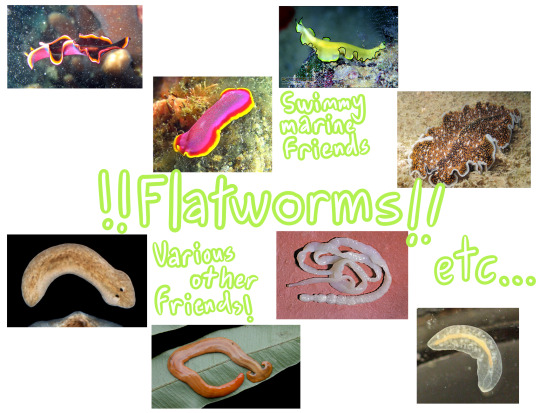
Flatworms are another very diverse group of worms, having many species both terrestrial and aquatic, however mostly I want to put attention into the free-swimming marine flatworms. They may swim beautifully (and fence with grace), but they are nevertheless invertebrates! Flatworms can live a variety of different lifestyles, from predators to parasites.
Amphibians (class Amphibia)

We've made it into vertebrates now! Amphibians include frogs, salamanders, and caecilians. While they have limbs with digits in their adulthood*, they can be easily confused for fish in their larval stages! This is no surprise, as they use gills to breathe underwater and tadpoles lack any limbs at all for a while. Many amphibians later transition into a terrestrial or semiaquatic way of life and lose their gills, not to mention gain their digit-having limbs.
(*excluding caecilians)
...Well, many amphibians do this, but not all. It's important to mention there are also species of aquatic salamanders which can bear great resemblance to fish with their elongated bodies! Amphiumas, which are sometimes mistakenly called "conger eels" (which is an actual species of fish), are aquatic salamanders with small residual limbs and both working gills and lungs. Giant salamanders and mudpuppies/waterdogs have lungs and gills as well, and lead an aquatic lifestyle — olms are close relatives of mudpuppies. Sirens, meanwhile, lack hind limbs and only have small front limbs, along with retaining their gills in adulthood. Among aquatic salamanders I also want to bring up one most often talked about species: the axolotl! They remain in their larval form, have external gills and lead an aquatic lifestyle. It can be hard to tell with aquatic salamanders sometimes, but these friends of ours are amphibians and not fish, even if they've rejected the land life.
Caecilians are a bit less known overall, but they can also cause a lot of confusion due to their long, limbless body. While most caecilians live underground, some are aquatic in nature, and can therefore be mistaken for fish! However, caecilians breathe via the use of their lungs and through the skin and don't have any gills at all.
Reptiles (class Reptilia)

Most commonly mistaken for fish in this group are sea snakes, sea kraits and water snakes, sea turtles, turtles, penguins, and other (semi)aquatic birds. Sea snakes and water snakes bear a very strong resemblance to eels, but they are indeed just snakes adapted to an aquatic or a semiaquatic lifestyle! The same goes for sea turtles, turtles overall, and penguins. They all need to breathe air and they lack fins, even if their flippers, webbed feet and built-in paddles may look like fins! They also have wholly different types of scales (or feathers!!) than what fish have, even if they share the feature. I assume that other aquatic reptiles, like the marine iguana and crocodilians are better read as reptiles thanks to their limbs with digits, but I want to give them a reptile shoutout anyway. They’re aquatic or semiaquatic, but they are air-breathers and fin-lackers all the same!
I also want to mention one specific extinct group of reptiles, ichtyosaurs! These marine reptiles were rather shark- or dolphin-like in appearance, which is actually a really good example of convergent evolution! Like all other reptiles, they also needed to breathe air and they had... erm... well, I'm not sure if I can call the bones in their flippers digits, but, that's what they used to be, so...? They were cool reptiles and among my favourites! There were many other aquatic reptiles too, but I will only mention just the ones now. A paleontology account would be better-suited to list you allll the marine reptiles.
Mammals (class Mammalia)
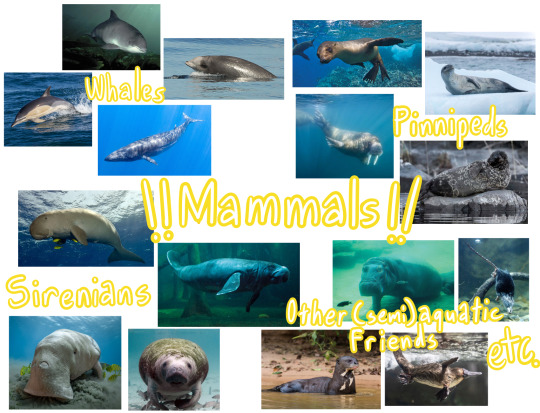
Our home class! Some of the aquatic friends we have in this class include whales like baleen and beaked whales, dolphins (orcas go here), porpoises, belugas, narwhals and sperm whales, pinnipeds like seals, sea lions, walruses, and sirenians like manatees, (occasionally known as sea cows) and dugongs! We also have some semiaquatic buddies like hippopotamids, otters, beavers and platypuses! Whales and pinnipeds especially often cause a lot of confusion due to their very streamlined, fishy appearance. They are, however, air breathers that feed their young with milk (some dolphin calves are even born with some hair), and their ancestors were land mammals! The same goes for pinnipeds and sirenians too. True seals, fur seals and sea lions still have fur even! Hippos, otters, beavers and platypuses are a bit more obvious as mammals with their fur and.. distinct air-breathing.. but I wanted to mention them anyway. Their adaptations to aquatic life are just one example of how fascinating evolution can be!
And here we are! A hopefully comprehensive list of fishes and non-fishes, beginning with the ever-shifting story of the term "fish", phylogeny, and why some animals are called fish when they really aren't. I hope you have found useful and interesting information in this post, and perhaps learned something new! I bid you a farewell! :D
#fish guide#fish essay#fish#fish facts#fishfact#marine biology#biology#zoology#long post#jawless fish#cartilaginous fish#ray-finned fish#lobe-finned fish
270 notes
·
View notes
Text
Thinking about love in season 2 of The Bear and how Carmy seems to conceptualize "love" and "fun" as opposites — because for him, they historically have been. It's something I really noticed in Fishes (2x06): how vocally and genuinely everyone in his family — including in-laws and functionally adoptive members like Richie and the Fak siblings — loves each other, but also how deeply entwined that love is with stress and chaos and criticism.
Natalie is nicknamed, by people who love her, after a mistake she made years ago and which is still held over her head when she tries to help in the kitchen. Donna loves her children and is loved by them in turn, but she's constantly on the edge of a meltdown, unable to offer or accept support. She spends hours cooking them a beautiful dinner, and then she drives a car through the wall. Michael reminds Carmy he loves him and tries to give him advice, and then he gets in a massive fight with Uncle Lee at the dinner table and starts throwing forks. Cooking is clearly so important to his family, but doing this activity they love, and especially doing it around the people they love, so rarely results in a feeling of "amusement or enjoyment."
And so it's no surprise, really, that the career Carmy loves is one that gives him panic attacks and made him throw up before work every day, or that he (and Natalie and Sydney) not only decide on such a radical transformation of the restaurant but give themselves a ridiculously sort timeline to complete it. He's stressed and miserable a lot of the time, but is it really something he loves if he doesn't feel that way?
#the bear#the bear s2 spoilers#carmy berzatto#slightly unformed bc i just finished watching and my brain spat this out#side note: i think this association between love and chaos is why the family but especially carmy has such a problem with pete#he's too normal and sweet#everyone claims not to understand the 7 fishes but he's the only one who threatens the tradition by bringing an 8th fish#he's also the only one who never calls natalie sugar#i'm not actually that invested in pete as a character idk how he ended up as the subject of my tag essay#kvetch oc
215 notes
·
View notes
Text
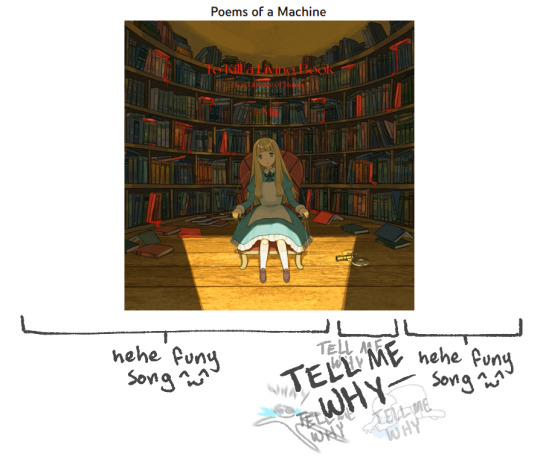
cant come in to work today they put on poems of a machine again. yea its gonna be an all day thing. sorry
#point @ image. haha i tell litle joke . the entire second half of the song guts me like a fish routinely <33#projmoon#piktalk#songs that make me want 2 write another manic essay. songs that . yeag ;;
90 notes
·
View notes
Text
I’ve said it before and I’m sure others have, but whitepine 2 once again uses stillness so well. We have time to linger on shots and moments. Pyro leaves the frame and we stay for several moments, looking on an empty alleyway. We stay sitting in the stillness with him while Ivory moves around. Ivory stands still at the edge of the forest, and we take the time to watch her walk out into it
And that contrasts so well with the moments where we aren’t still! Time passes and we’re barely there as Ivory helps out in the kitchen, the music and the shots going by fast as Ash (I think was their name? I’ve not gotten everyone down yet) yells out short, chopped instructions. Everything feels so, so frantic, and then all of a sudden everything is still again. And I love it
#I’m so. AUGH. THE COMPOSITION. THE WAY WE LINGER#ITS BEAUTIFUL#whitepine#ivorycello#mcyt#fish’s-essays
123 notes
·
View notes
Text
due to personal reasons i will be donning my seal-coat and escaping my responsibilities by returning to the sea
#i was not built for college i was built to be a lil guy#would very much prefer to be a selkie catching fish rather than just some guy writing essays#selkie#selkies#aough#mythical creatures#mythology#selkie folklore#folklore#dragons chatting
192 notes
·
View notes